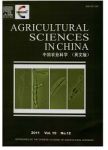Deciphering the morpho–physiological traits for high yield potential in nitrogen efficient varieties(NEVs):A japonica rice case study
Deciphering the morpho–physiological traits for high yield potential in nitrogen efficient varieties(NEVs):A japonica rice case study作者机构:Jiangsu Key Laboratory of Crop Genetics and Physiology/Jiangsu Key Laboratory of Crop Cultivation and Physiology/Jiangsu Co-Innovation Center for Modern Production Technology of Grain CropsYangzhou UniversityYangzhou 225009P.R.China Joint International Research Laboratory of Agriculture and Agri-product SafetyMinistry of EducationYangzhou UniversityYangzhou 225009P.R.China
出 版 物:《Journal of Integrative Agriculture》 (农业科学学报(英文版))
年 卷 期:2022年第21卷第4期
页 面:947-963页
核心收录:
基 金:supported by the grants from the National Natural Science Foundation of China(32071843,31901444 and 31901445) the National Key Research and Development Program of China(2016YFD0300206-4 and 2018YFD0300800) the Priority Academic Program Development of Jiangsu Higher Education Institutions,China(PAPD) the Top Talent Supporting Program of Yangzhou University,China(2015-01) the Natural Science Foundation of Jiangsu Province,China(BK20190880) the Natural Science Foundation of Jiangsu Higher Education Institutions,China(19KJB210019)
主 题:rice N-efficient varieties nitrogen use efficiency root morpho–physiological traits nitrogen translocation leaf morphology canopy structure
摘 要:The use of nitrogen(N)-efficient rice(Oryza sativa L.) varieties could reduce excessive N input without sacrificing yields. However, the plant traits associated with N-efficient rice varieties have not been fully defined or comprehensively explored. Here, three japonica N-efficient varieties(NEVs) and three japonica N-inefficient varieties(NIVs) of rice were grown in a paddy field under N omission(0 N, 0 kg N ha^(-1)) and normal N(NN, 180 or 200 kg N ha^(-1)) treatments. Results showed that NEVs exhibited higher grain yield and nitrogen use efficiency(NUE) than NIVs under both treatments, due to improved sink size and filled-grains percentage in the former which had higher root oxidation activity and greater root dry weight, root length and root diameter at panicle initiation(PI), as well as higher spikelet-leaf ratio and more productive tillers during the grain-filling stage. Compared with NIVs, NEVs also exhibited enhanced N translocation and dry matter accumulation after heading and improved flag leaf morpho-physiological traits, including greater leaf thickness and specific leaf weight and higher contents of ribulose^(-1),5-bisphosphate carboxylase/oxygenase, chlorophyll, nitrogen, and soluble sugars, leading to better photosynthetic performance. Additionally, NEVs had a better canopy structure, as reflected by a higher ratio of the extinction coefficient for effective leaf N to the light extinction coefficient, leading to enhanced canopy photosynthesis and dry matter accumulation. These improved agronomic and physiological traits were positively and significantly correlated with grain yield and internal NUE, which could be used to select and breed N-efficient rice varieties.



